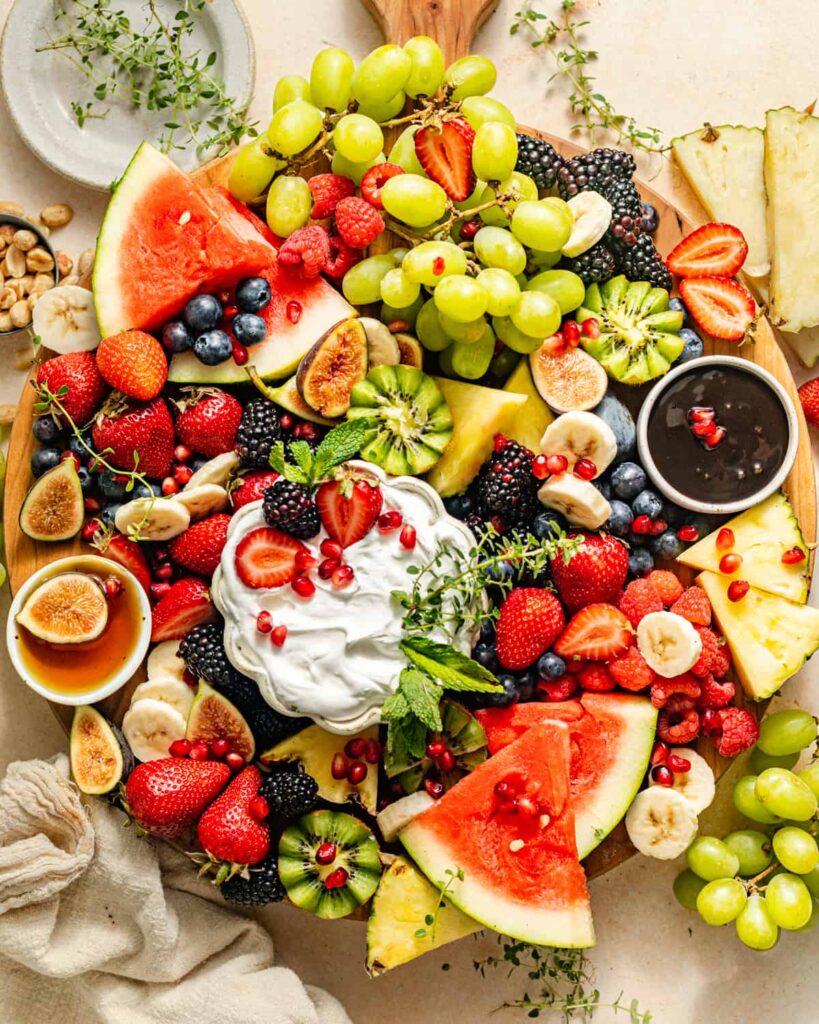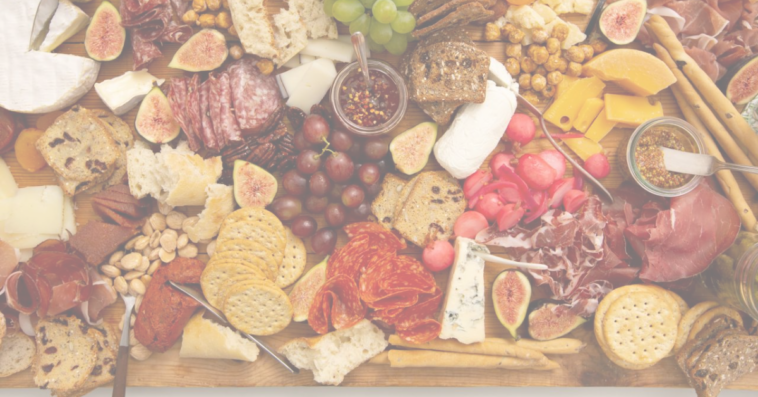How to make a Charcuterie Board is no more a hassle with our guide. Charcuterie refers to a culinary art focused on the preparation, preservation, and presentation of a variety of cured and processed meats specifically in French Cuisine. The term originates from the French words “chair” (flesh) and “cuit” (cooked), reflecting the traditional methods of preserving meats through techniques such as curing, smoking, and fermentation.

The art of assembling a charcuterie board transcends the ordinary dining experience, offering a celebration of diverse flavors and textures that cater to personal preferences. Creating the perfect charcuterie board is an endeavor in culinary artistry, and this step-by-step guide will walk you through every aspect, from choosing the right board to selecting a harmonious array of meats, cheeses, condiments, and accompaniments.
A Step-by-Step Guide on How to Make a Charcuterie Board
Let us pave the way for you to create the most tempting and delicious serving platter full of delectable meats, cheese, fruits, crackers and much more. However, if you do not feel like making it at home, you can always enjoy it at your favorite restaurant. And if you are in Detroit do not miss out on the Planche de Charcuterie from the famous Le Supreme Restaurant.
Choose the Right Board
Before diving into the selection of meats and cheeses, it’s essential to choose the right board. Consider the size and shape that suits your gathering, balancing practicality with aesthetics. Whether it’s a rustic wooden plank or a sleek slate slab, the board sets the stage for the culinary masterpiece you’re about to create.
Selecting Meats for the Board
Variety is the key when it comes to selecting cured meats for your charcuterie board. From the delicate folds of prosciutto to the bold flavors of salami and chorizo, explore different textures and flavor profiles. Consider any dietary restrictions or preferences of your guests as you curate a selection that promises to tantalize the taste buds.
Selecting the Cheeses
Complement the array of meats with a carefully curated selection of artisanal cheeses. Aim for a balance between soft, semi-soft, and hard cheeses, incorporating different milk types such as cow, goat, and sheep. The cheese choices should offer a range of flavors and textures, creating a delightful journey for the palate.
Accompanying Condiments
Elevate the flavor profile of your charcuterie board by introducing an array of condiments. Pair cured meats and cheeses with high-quality mustards, jams, honey, and nuts to provide sweet and savory contrasts. Add pickles and olives to introduce tangy elements, creating a symphony of flavors on the palate.
Add Fresh Fruits and Berries
Infuse vibrancy and freshness into your charcuterie board with an assortment of fresh fruits and berries. Consider the season and incorporate colorful, seasonal fruits to enhance both the visual appeal and taste of the board. The sweetness of fruits adds a delightful contrast to the savory and salty components.
Bread and Crackers Selection
Choose the right carriers for your meats and cheeses by selecting artisanal bread and crackers. Include a variety to cater to different tastes, and consider offering gluten-free options to accommodate dietary needs. The bread and crackers provide a neutral canvas for the diverse flavors on the board.
Garnishing for Visual Appeal
Elevate the visual appeal of your charcuterie board by incorporating garnishes. Fresh herbs like rosemary or thyme add aroma and aesthetic charm, while edible flowers contribute to the overall elegance of the presentation. Play with different heights and arrangements to create a visually stunning display.
How to Arrange the Charcuterie Board?
Creating an inviting layout is an essential aspect of crafting a charcuterie board. Arrange items in a balanced and appealing manner, grouping similar items for easy access. Experiment with heights and textures to create visual interest, ensuring a feast for both the taste buds and the eyes.
Follow these assembling steps to have a presentable charcuterie board.
- Start with an appropriately sized board or platter.
- Place larger items first, like wheels of cheese or bowls of condiments.
- Arrange cured meats in a loose, natural manner, avoiding stacking.
- Position different types of cheeses across the board, varying shapes and sizes.
- Intersperse accompaniments like mustards, preserves, and honey.
- Scatter fresh fruits and nuts for color, freshness, and texture.
- Include bread and crackers, arranging them in different sections.
- Fill empty spaces with smaller items like dried fruits, nuts, or edible flowers.
- Consider height by stacking or layering certain items for dimension.
- Garnish with fresh herbs, such as rosemary or thyme, for a fragrant touch.
- Step back, assess the balance, and make final adjustments for an inviting and visually appealing charcuterie board.
What are 3 kinds of Charcuterie Board?
Charcuterie is a versatile culinary art that extends beyond traditional cured meats, offering a diverse range of options to tantalize the taste buds. While cured meats are undoubtedly a staple, three main categories showcase the richness and variety within the world of charcuterie:
Cured Meats
This category includes a plethora of flavorful options such as prosciutto, salami, chorizo, and bresaola. Each type of cured meat brings its unique texture, taste, and aroma to the charcuterie board, contributing to a rich and varied experience.
Cheeses

Artisanal cheeses play a significant role in charcuterie, providing a delightful contrast to the savory and salty nature of cured meats. From creamy Brie to sharp cheddar, the cheese selection can include various textures and flavors, adding complexity to the overall board.
Accompaniments
Beyond meats and cheeses, charcuterie often features an array of complementary accompaniments. This can range from high-quality mustards and jams to honey, nuts, pickles, olives and some other GMO foods for variety. These accompaniments introduce sweet, tangy, and crunchy elements that enhance the overall flavor profile.
Is Charcuterie Always Meat? Exploring Non-Meat Options
While charcuterie traditionally revolves around cured meats, modern interpretations have expanded the concept to embrace non-meat alternatives. Charcuterie boards can cater to a variety of dietary preferences and restrictions, making room for innovative and inclusive options. Some non-meat alternatives to consider include:
Cheese Boards
A cheese-centric charcuterie board features an array of artisanal cheeses, accompanied by nuts, dried fruits, and honey. This vegetarian-friendly option offers a rich and diverse palette of flavors without any cured meats.
Vegan Charcuterie
For those following a plant-based diet, a vegan charcuterie board includes plant-based cheeses, marinated vegetables, hummus, olives, and various nuts. These boards showcase the art of crafting flavorful combinations without traditional animal products.
Seafood Charcuterie
Incorporating smoked or cured seafood, such as salmon or trout, provides a unique twist to charcuterie. Seafood charcuterie boards can include an assortment of pickled vegetables, capers, and different types of seaweed.
Fruit Charcuterie

This fresh take on the classic board features an assortment of juicy berries, melons, and tropical slices, beautifully arranged alongside honey-drizzled figs and grapes. A delightful alternative to traditional spreads, fruit charcuterie offers a refreshing, colorful, and naturally sweet experience—perfect for light desserts or adding vibrancy to any gathering.
Conclusion: What is typically on a Charcuterie Board?
A charcuterie board is a culinary delight featuring a curated selection of cured meats like prosciutto and salami, paired with artisanal cheeses ranging from creamy Brie to robust blue cheese. Accented with high-quality mustards, fruity preserves, and honey, this board offers a symphony of flavors.
Embrace creativity and customization, tailoring each board to the occasion and preferences of your guests. As you embark on this culinary adventure, share the joy of creating and savoring a charcuterie masterpiece, encouraging others to explore the world of charcuterie with equal enthusiasm.
People also read : Can you Bring Food on Plane?




